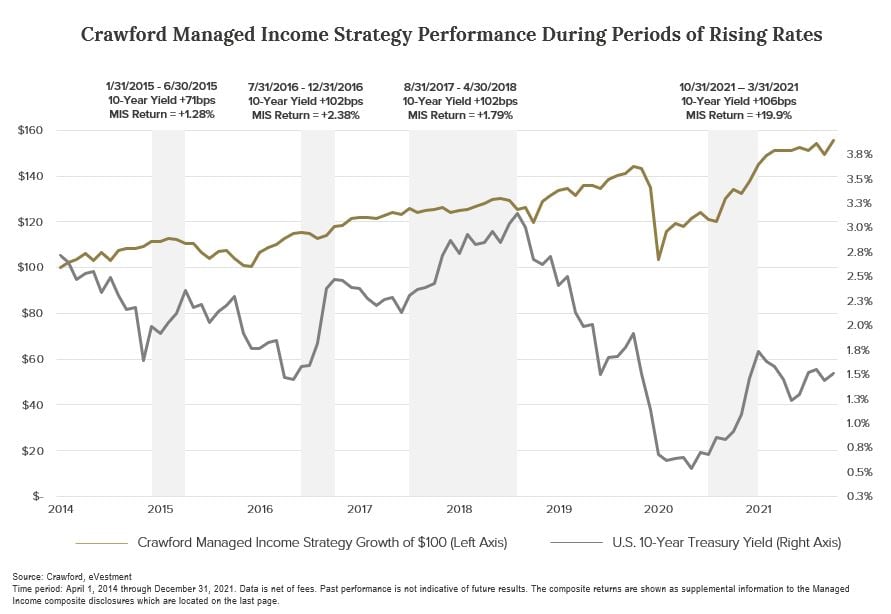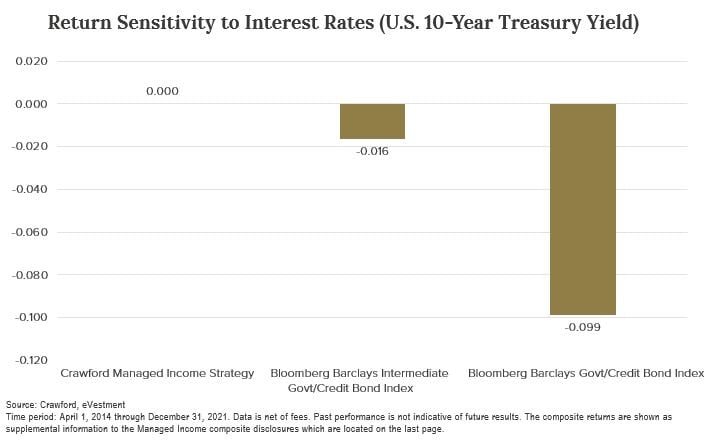
Given the potential for rising interest rates in the year ahead, the Crawford Managed Income Strategy is a compelling option for 401k participants seeking interest rate risk protection and high current income. The strategy can exist as a standalone strategy, part of a multi-managed daily valued income model, or as a complement to a more traditional mix of stocks and bonds. Since its inception in 2014, the strategy has offered its investors protection against both principal erosion and permanent loss of capital, while consistently generating over 5% yield by purchasing a mix of dividend-paying common stocks, preferred equity, energy infrastructure c-corporations, real estate investment trusts, and corporate bonds. This is an actively managed portfolio that emphasizes steady income generation (yield) through market cycles, regardless of the volatility inherent in the capital markets. For a strategy of this nature, income is the primary investment objective, and we mitigate risk through both quality and diversification.The Role of Quality. We have found that investors who are looking for current income in a lower-yielding environment oftentimes seek yield by investing in lower-quality, higher-volatility securities. We believe this is a poor risk/reward tradeoff and instead have built a portfolio that pursues lower volatility through high-quality securities and aims to be risk-controlled with regard to macroeconomic variables.
The Role of Diversification. The portfolio is focused yet well-diversified across 30-40 holdings in all market capitalization spectrums. The variety of income-producing asset classes utilized by the strategy allows its investors the opportunity to achieve greater diversification, and in-turn, greater risk mitigation. Crawford has identified four major risk categories inherent to the higher income subsets of the capital markets: interest rate risk, energy price risk, stock market risk, and credit risk. Through a process of disaggregation and analysis of the various risks associated with specific holdings in our portfolio, Crawford mitigates risk through diversification and balancing. Today, we address the forthcoming rising interest rate environment.
The Managed Income Strategy Today. The Federal Reserve’s call for “transitory” inflation has been challenged by much more persistent and elevated inflation than expected. This dynamic has left them behind the curve and forced a dramatic policy shift. The end of quantitative easing in March is widely expected to be followed by a series of Federal Funds Rate increases as we move through the year.
You might wonder how the Managed Income Strategy will fare in the environment to come. Before proceeding, we’ll note that as we look to the future we don’t believe our ability to predict changes in interest rates is a sustainable, value-added component of our management process. Instead, we look to the opportunities that the markets provide within our investment universe and attempt to construct a well-balanced, risk-managed portfolio.
Since the strategy’s inception in May of 2014, there have been four time frames that we can identify as “rising rate periods,” defined by a greater than a 50bps increase in the U.S. Treasury 10-year note yield to maturity. The chart below shows that while rising rates may be a headwind to the strategy we have thus far managed to generate positive total returns in each of these rising rate periods.

Past performance is not indicative of future results. The composite returns are shown as supplemental information to the Managed Income GIPS Composite Report.
While we can calculate the duration of our fixed income holdings, we are only able to provide an estimate for the complete portfolio due to the substantial position in equities. We can, however, calculate the overall interest sensitivity of the portfolio to changes in interest rates and compare the results to the same measure for several popular fixed income indices. In this case, we can confidently show that since inception, the portfolio has exhibited interest rate sensitivity similar to the Barclays Intermediate Govt/Credit Index and much less than the Barclays Aggregate Government Credit Index. This is likely less sensitive than most investors would expect from an income strategy.

In an effort to protect our investors, we are seeking to access yield without taking on a lot of duration (interest-rate sensitivity). This is accomplished through security selection and portfolio management. By naturally offsetting longer duration assets with income-producing, asset-sensitive positions, we are able to control the portfolio’s aggregate sensitivity to interest rates. To do so we utilize a proprietary, internally developed, risk-management methodology that carefully considers each position’s contribution to the portfolio’s overall risk characteristics. Our goal remains to provide yield and preserve capital, and at this time we are attempting to do what we can to continue insulating the portfolio from the potentially negative outcome associated with rising interest rates.
Conclusion. For clients seeking income and looking to position themselves for the environment ahead, the Crawford Managed Income Strategy is an attractive alternative. We have built a portfolio with a higher expected yield than the market while mitigating much of the volatility typically associated with the higher-yielding subsets of the capital markets through security selection and careful portfolio construction.
Crawford Investment Counsel is an independent investment adviser registered under the Investment Advisers Act of 1940, as amended. Registration does not imply a certain level of skill or training. More information about Crawford Investment Counsel, including our investment strategies, fees and objectives, can be found in our Form ADV Part 2, which is available upon request.
The widely recognized benchmark(s) in this presentation are used for comparative purposes only. The NASDAQ U.S. Multi-Asset Diversified Income Index is designed to provide exposure to multiple asset segments, each selected to result in a consistent and high yield for the index. The Index is comprised of securities classified as U.S. equities, U.S. Real-Estate Investment Trusts (REITs), U.S. preferred securities, U.S. master-limited partnerships (MLPs) and a high yield corporate debt Exchange-Traded Fund (ETF). The Bloomberg Barclays Intermediate Government/Credit Bond Index is an unmanaged index that tracks the performance of intermediate term US government and corporate bonds. The Bloomberg Barclays US Government/Credit Bond Index is a broad-based flagship benchmark that measures the non-securitized component of the US Aggregate Index. It includes investment grade, US dollar-denominated, fixed-rate Treasuries, government-related and corporate securities. The volatility (beta) of the portfolios may be greater or less than the benchmarks. It is not possible to invest directly in these indices.
CRA-22-066
The opinions expressed herein are those of Crawford Investment Counsel and are subject to change without notice. This material is not financial advice or an offer to sell any product. Forward-looking statements cannot be guaranteed. This document may contain certain information that constitutes “forward-looking statements” which can be identified by the use of forward-looking terminology such as “may,” “expect,” “will,” “hope,” “forecast,” “intend,” “target,” “believe,” and/or comparable terminology. No assurance, representation, or warranty is made by any person that any of Crawford’s assumptions, expectations, objectives, and/or goals will be achieved. Nothing contained in this document may be relied upon as a guarantee, promise, assurance, or representation as to the future. Crawford Investment Counsel is an investment adviser registered with the U.S. Securities and Exchange Commission. Registration does not imply a certain level of skill or training.
These Perspectives on Strategy Specific
600 Galleria Parkway
Suite 1650
Atlanta, Georgia 30339
Main: 770.859.0045
Fax: 770.859.0049
Email: info@crawfordinvestment.com

Copyright © 2025 | Crawford Investment Counsel, Inc. | All Rights Reserved.
Crawford Investment Counsel, Inc. (“Crawford”) is an independent investment adviser registered under the Investment Advisers Act of 1940, as amended. Registration does not imply a certain level of skill or training. More information about Crawford Investment Counsel, including our investment strategies, fees and objectives, can be found in our Form ADV Part 2A and our Form CRS.
Web Site Development by: Goodwood Consulting
You are now leaving the Crawford Investment Counsel website and accessing the
Crawford Investment Funds website.
You are now leaving theCrawford Investment Funds website
and accessing the Crawford Investment Counsel website.
To help us personalize the site to your needs,
please select one of the following that best describes you.
You are now entering the area of the Crawford Investment Counsel website
that is for Consultant & Investment Professional Use Only.
You are now leaving the Crawford Investment Funds website and accessing the
Ultimus Fund Solutions website.
You are now entering the area of the Crawford Investment Counsel website
that is for Endowment & Foundation Use Only.